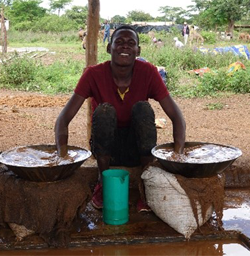Activities of NIMD
Cases of past international contributions
The National Institute for Minamata Disease engages in surveys,
technical assistance and other initiatives to address major mercury issues,
not only in Japan but also on a global scale.



1
Amazon river basin, Brazil (small-scale gold mining)
Large amounts of metallic mercury used in illegal ASGM have leaked into rivers in the Amazon River basin, raising concerns about health hazards for local residents. Therefore, through joint research with local universities and research institutes, we strengthened the laboratory to improve mercury analysis capacity on the Brazilian side, train mercury analysis technicians, improve health monitoring capacity, improve public awareness capacity, and improve clinical diagnosis capacity. JICA projects were carried out over three terms and 14 years with the aim of developing human resources for the future.


2
Guizhou Province, China (organic chemical plant wastewater)
In collaboration with Guizhou Province and government researchers, we conducted a mercury exposure survey of residents in the areas around the plant and the control areas without the plant to investigate the effects of inorganic mercury in soil and collected and analyzed soil samples to analyze the chemical form of mercury in contaminated soil.


3
Guizhou Province, China (mercury mine)
We conducted a collaborative study to investigate the health effects of mercury exposure in mercury mine workers. Hair and urine were collected, and a health assessment was conducted based on exposure to mercury vapor.


4
Nicaragua (caustic soda production plant wastewater)
Following a request from the Nicaraguan government, the Inter-American Development Bank (IDB) reached NIMD via its Japan fund section, requesting cooperation. We worked with local researchers to conduct field surveys in the mercury-polluted region, along with providing technology transfer relating to mercury analysis necessary for surveys. The activity subsequently transitioned into JICA's technical cooperation project.


5
Kazakhstan (organic chemical plant wastewater)
Addressing a request from the Kazakh government, JICA requested cooperation from NIMD. In the form of a JICA expert dispatch project, "Nura River Mercury Environment Monitoring Project," NIMD sent its staff to transfer mercury analysis technology to local counterparts.


6
French Guiana (small-scale gold mining)
Responding to a request from a French NPO, NIMD conducted a mercury content analysis of hair samples taken from local residents, which brought to light relatively high levels of mercury concentration in them. NIMD then travelled to the area at its own initiative to survey mercury concentration in local fish as well as in hair samples of local residents.


7
Sulawesi Island, Indonesia (small-scale gold mining)
NIMD transferred mercury analysis technology to a local university and also performed a joint survey of mercury pollution in the river basin.


8
Tanzania (small-scale gold mining)
We conducted a fact-finding survey of artisanal and small-scale gold mining (ASGM) being carried out in the five areas of Shingida, Kahama, Sekenke, Mwime, and Geita are located northwest of the capital city, Dodoma in Tanzania. We mainly surveyed the work sites as a preliminary investigation this time. Further monitoring of the exposure levels to mercury of the workers of ASGM and residents who are consuming fish from Lake Victoria around ASGM should be continued.